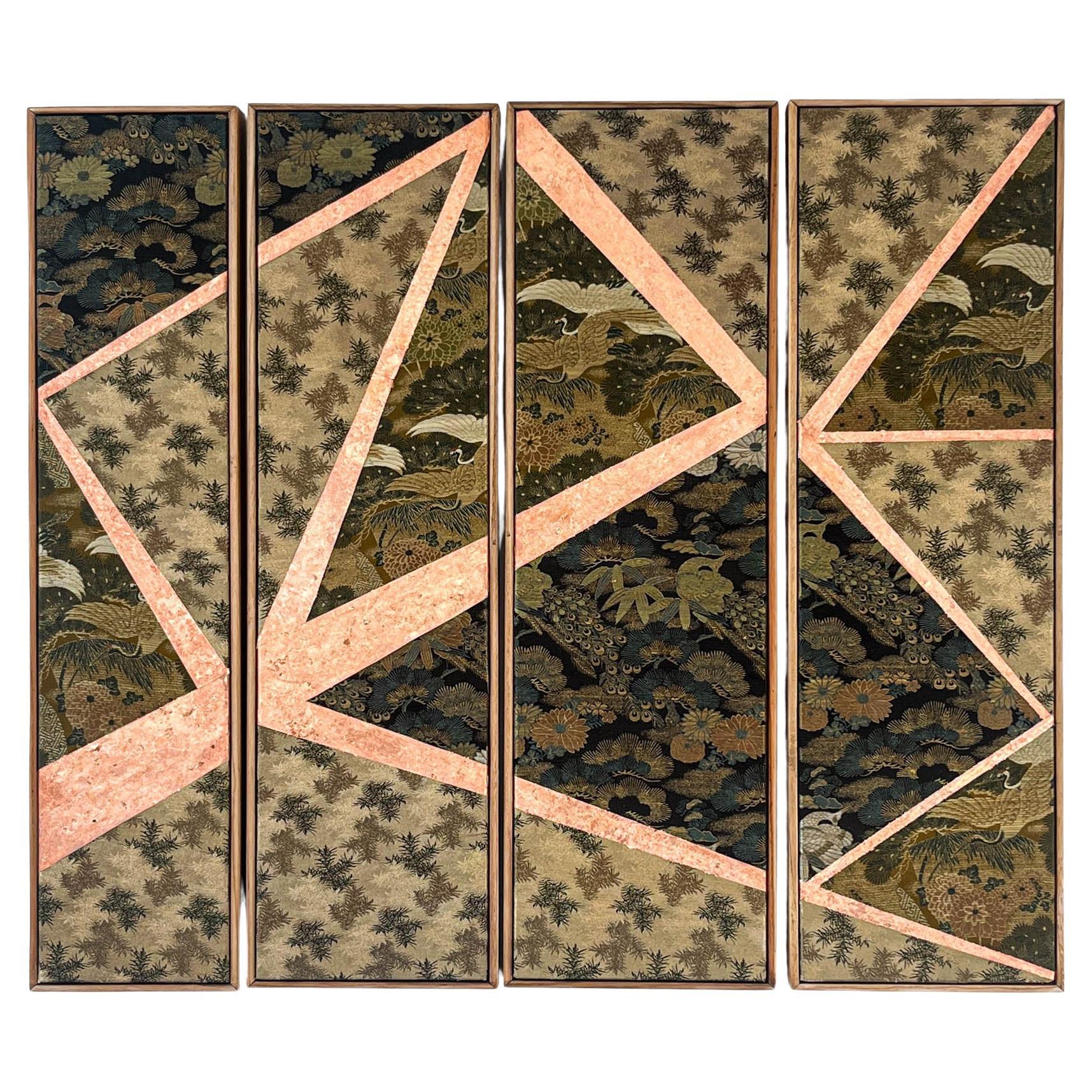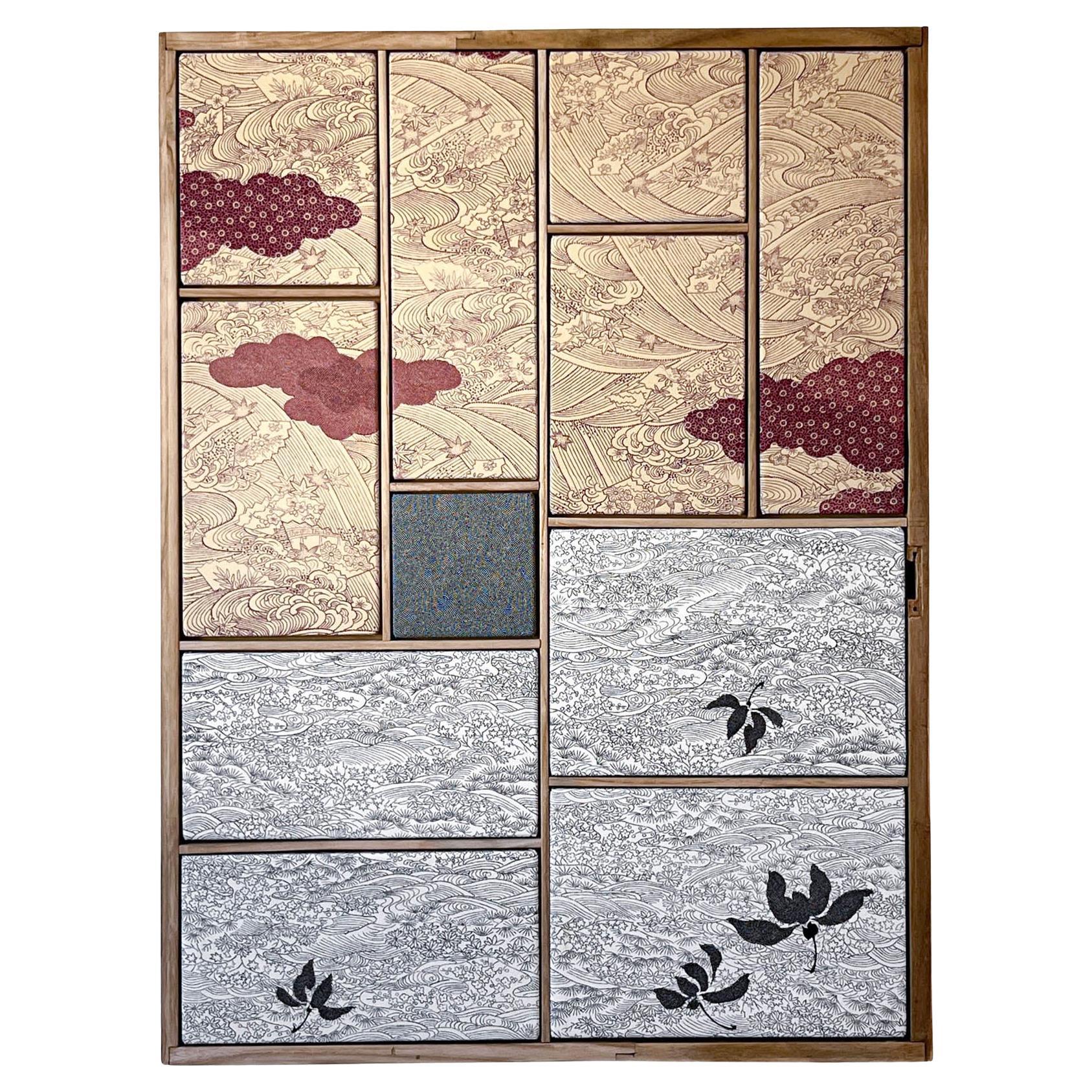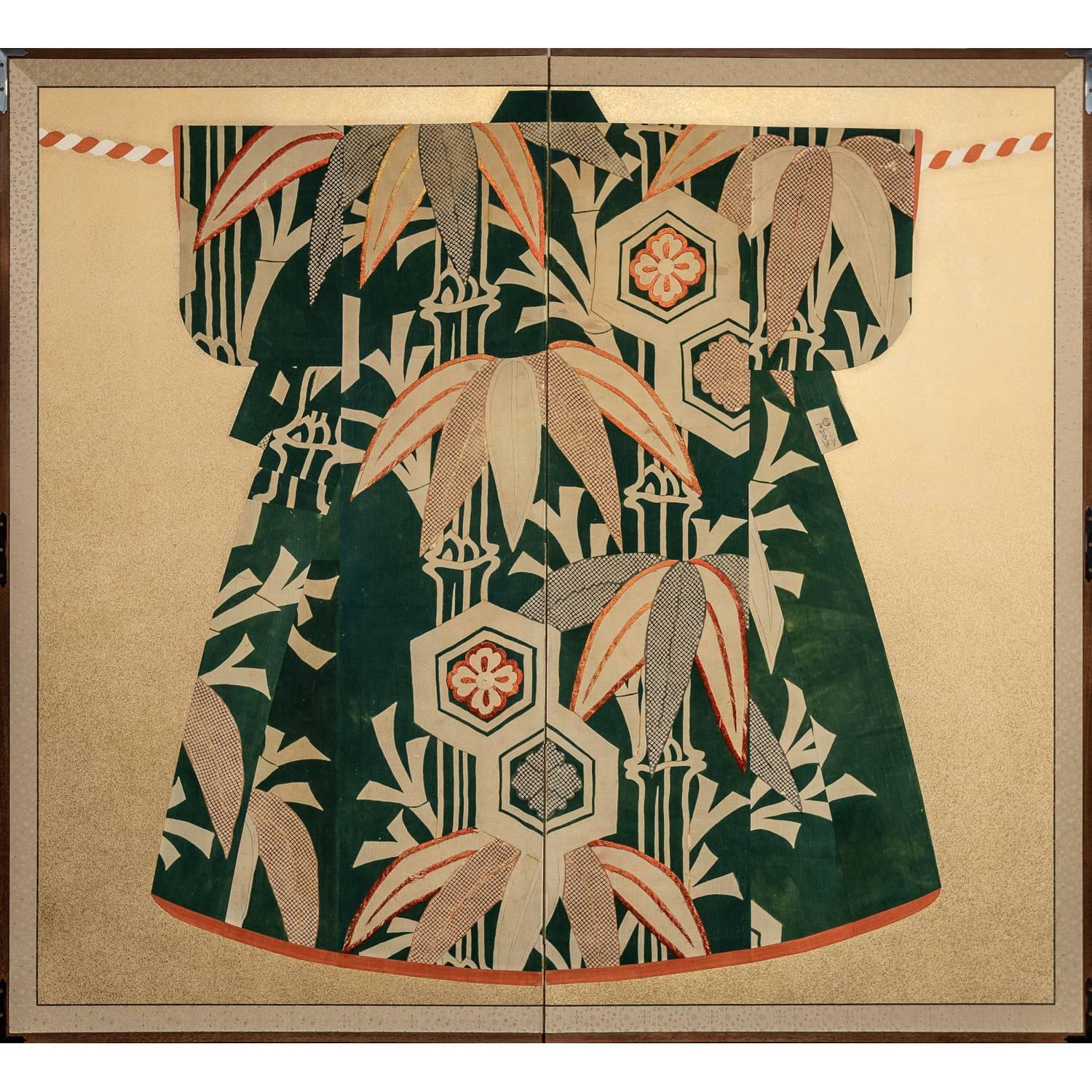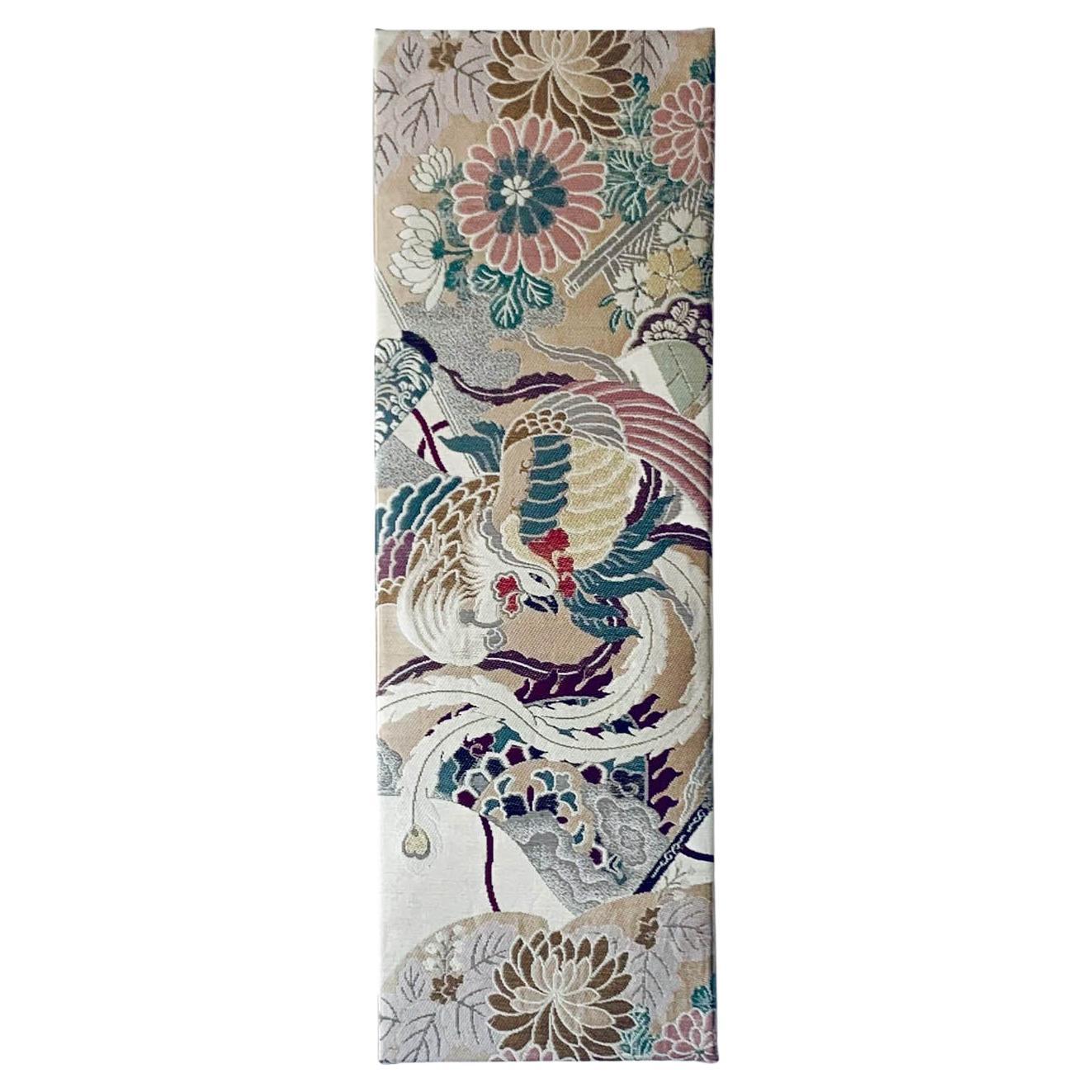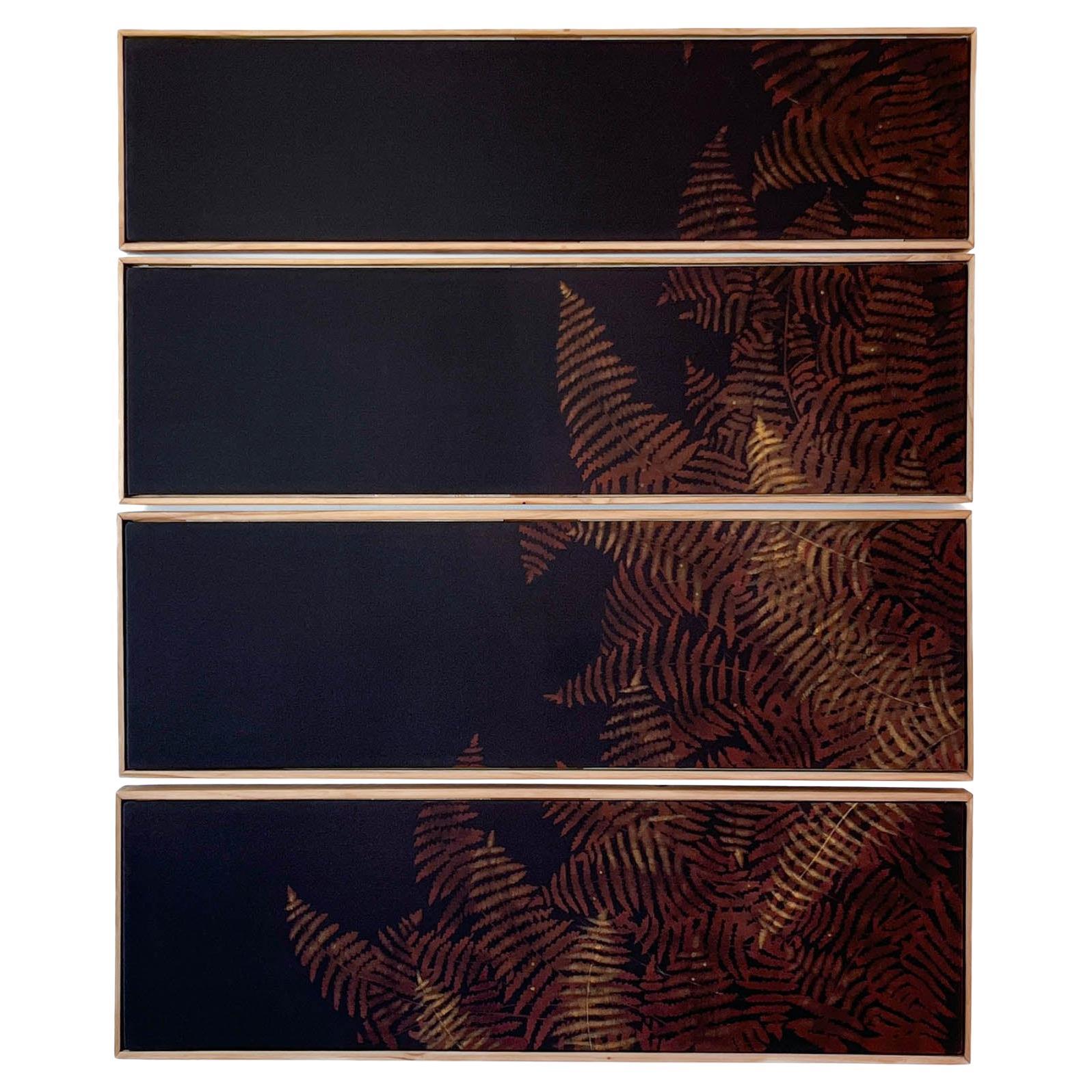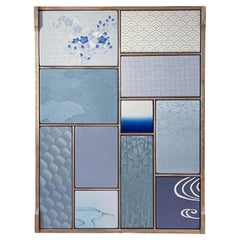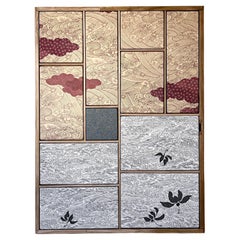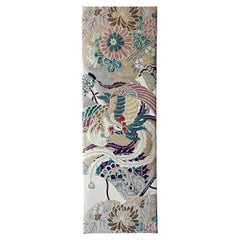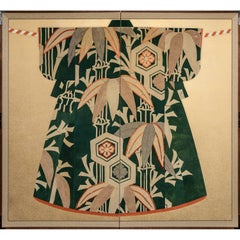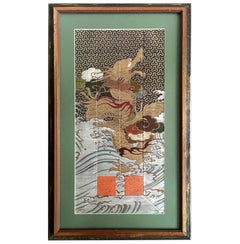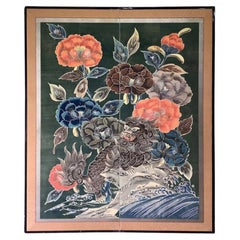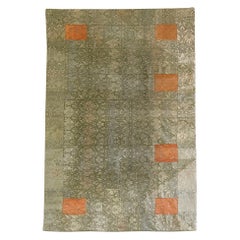Items Similar to Antique kimono textile art "Kobachi ~ Green Collection ~" by ikasu Green, Japan
Want more images or videos?
Request additional images or videos from the seller
1 of 21
Antique kimono textile art "Kobachi ~ Green Collection ~" by ikasu Green, Japan
$3,000
£2,290.49
€2,646.64
CA$4,211.43
A$4,694.08
CHF 2,462.82
MX$57,322.37
NOK 31,184.69
SEK 29,474.27
DKK 19,753
About the Item
This work is inspired by the green color palette, and is framed in paulownia wood originally used for a kimono chest-of-drawers.
In this artwork, the aim was to capture the wide palette of green color commonly used in antique kimono. Traditional Japanese culture, represented by the kimono, and wood, an integral element of Japanese craftsmanship, were used to bring this vision to life.
I used pieces of kimono, haori and kimono lining that could no longer be used as clothing and kiritansu chest-of-drawers that would normally be discarded to create the ultimate upcycled piece.
The artwork is called "kobachi". Kobachi is a style of serving in Japanese cuisine, when small plates are positioned in a special way to satisfy both mouth and eyes.
<< Explanation and meaning of pattern and colors >>
Green symbolizes "healing" and "harmony." Even in the Twelve-Layered Robes of the Heian period, green was always incorporated and worn by high-ranking women.
Green is associated with nature, such as trees and grass, and has long symbolized youth and growth in Japan. The color is reminiscent of the vibrant green of growing bamboo, further emphasizing its connection to vitality. Green harmonizes well with many colors and is particularly fitting as a background color for floral patterns commonly depicted on furisode.
This artwork offers a rich array of expressions, from bright and shining green to deep and subdued shades, each complemented by unique patterns and dyes.
"Wakakusa-iro 若草色" refers to the vivid yellow-green reminiscent of fresh spring grass. Originating from the color "wakakusa" used in Heian period layered robes, it depicts the scenery of early spring meadows where young grass sprouts, with a color scheme of "light blue front, dark blue back." The term "waka" means "young" in Japanese and conveys meanings of freshness, youthfulness, and newness, making "wakakusa" a seasonal term in haiku poetry. In the Heian period (8th cent.) literary work "Tales of Ise," the freshness of "wakakusa" was metaphorically applied to young women.
On the other hand, "Oitake-iro 老竹色" describes a slightly dull, grayish-green color resembling aged bamboo. In contrast to the youthful vibrancy of "wakatake-iro", it takes on a muted hue with a hint of ashiness. Traditionally, the term "oi 老" (meaning "old" in Japanese) was used to denote subdued and dull colors compared to the bright and vivid tones represented by "waka."
Furthermore, the central black element adds a striking contrast to the piece. Among traditional colors, "Binrojiguro 檳榔子黒" stands out as an elegant black with a hint of blue undertones. It's derived from a dyeing process where indigo is used as an underlayer, followed by dyeing with the fruit of the betel palm tree, "binroji," resulting in the highest quality black dye. Due to its association with the aristocracy and its use in patterned garments, it's considered the pinnacle of black hues. Another variant of this dyeing process involves using red as the underlayer, known as "Benishitaguro 紅下黒," which produces a softer black with a hint of redness. Interestingly, "Benishitaguro" is also referred to as "Binrojiguro."
This combination of colors and textures not only adds depth to the artwork but also reflects the intricate traditions and symbolism deeply rooted in Japanese culture.
In feng shui, green is considered a color of naturalness, harmony, stability, friendship, peace, and adaptability.
In this work, green is represented in different shades and tones to show the fascinating Japanese traditional dying techniques.
<< About the frame >>
Kiritansu - chest-of-drawers for kimono, is traditionally made from paulownia wood, a uniquely Japanese material closely tied to the world of kimonos.
Paulownia wood is known as the lightest wood in Japan, prased for its natural luster, resistance to moisture, and resilience against cracking. Since ancient times, it has been used in crafting furniture, chests, and musical instruments.
During the Edo period, it became customary to store cherished kimonos in paulownia chests, which offered fire resistance and protection from moisture and insects.
Traditionally, when a daughter was born, a paulownia tree would be planted. Upon her marriage, the tree would be cut down, and the wood would be used to craft a chest for her as a wedding gift.
Following the Ansei Earthquake during the late Edo period in 1855, paulownia chests gained popularity due to their ability to withstand fires and even float in water, thereby safeguarding their contents during floods.
I use antique kiritansu that can’t be used as furniture anymore to create basis and frames for my works. It adds them even more authentic atmosphere of traditional wabisabi spirit. Can you feel it?
- Creator:Kimono ikasu (Artist)
- Dimensions:Height: 33.47 in (85 cm)Width: 24.81 in (63 cm)Depth: 1.97 in (5 cm)
- Style:Japonisme (In the Style Of)
- Materials and Techniques:
- Place of Origin:
- Period:
- Date of Manufacture:1920
- Condition:
- Seller Location:Setagaya City, JP
- Reference Number:1stDibs: LU10079243303682
About the Seller
No Reviews Yet
Vetted Professional Seller
Every seller passes strict standards for authenticity and reliability
1stDibs seller since 2024
- ShippingRetrieving quote...Shipping from: Setagaya City, Japan
- Return Policy
Authenticity Guarantee
In the unlikely event there’s an issue with an item’s authenticity, contact us within 1 year for a full refund. DetailsMoney-Back Guarantee
If your item is not as described, is damaged in transit, or does not arrive, contact us within 7 days for a full refund. Details24-Hour Cancellation
You have a 24-hour grace period in which to reconsider your purchase, with no questions asked.Vetted Professional Sellers
Our world-class sellers must adhere to strict standards for service and quality, maintaining the integrity of our listings.Price-Match Guarantee
If you find that a seller listed the same item for a lower price elsewhere, we’ll match it.Trusted Global Delivery
Our best-in-class carrier network provides specialized shipping options worldwide, including custom delivery.More From This Seller
View AllAntique kimono textile art " Kobachi ~Marine Collection~ " by ikasu Blue, Japan
By Kimono ikasu
Located in Setagaya City, JP
This work is inspired by the blue color palette, and is framed in paulownia wood originally used for a kimono chest-of-drawers.
In this artwork, the aim was to capture the wide pale...
Category
Vintage 1920s Japanese Japonisme Paintings and Screens
Materials
Silk, Wood
Antique obi textile art " Pine forest ~ Longivety ~ " by ikasu Green , Japan
By Kimono ikasu
Located in Setagaya City, JP
<< Story behind the work >>
Obi fabric I used for this artwork is taken from three different over 100-years-old antique sashes, and is framed in wood taken from antique chest-of-dra...
Category
Early 20th Century Japanese Japonisme Paintings and Screens
Materials
Gold Leaf
Antique kimono textile art " Waves and clouds ~Eternity~ " by ikasu Beige, Japan
By Kimono ikasu
Located in Setagaya City, JP
This work is inspired by traditional hand-dying technique edo-komon, and is framed in paulownia wood originally used for a kimono chest-of-drawers.
It is elegantly framed with paulo...
Category
Vintage 1920s Japanese Japonisme Paintings and Screens
Materials
Silk, Wood
Vintage obi textile art "From the Ashes ~Serendipity~" by ikasu Beige, Japan
By Kimono ikasu
Located in Setagaya City, JP
About This Canvas
This canvas has been upcycled from an early 20th-century maru-obi, featuring a subtle yet sophisticated depiction of the phoenix—a legendary symbol of peace and ren...
Category
Vintage 1910s Japanese Japonisme Decorative Art
Materials
Canvas, Silk
Vintage kimono textile art "Fern ~Connection to Nature~" by ikasu Black , Japan
By Kimono ikasu
Located in Setagaya City, JP
This work uses an antique tomesode (festive kind of kimono) with fern design to evoke feelings of tranquility, harmony, and appreciation for the beauty of the environment. Can be used both vertically and horizontally.
It is elegantly framed with paulownia wood originally used for kimono chest-of-drawers, and is filled with storytelling and sense of luxury.
I used pieces of kimono that could no longer be used as clothing and kiritansu chest-of-drawers that would normally be discarded to create the ultimate upcycled piece.
<< Explanation of colors and patterns >>
In Japanese traditional culture, ferns, particularly the Japanese painted fern (Athyrium niponicum), hold several meanings and symbolisms:
・Elegance and Beauty: Ferns are admired for their graceful, delicate appearance and intricate leaf patterns. In Japanese aesthetics, they are appreciated for their natural beauty and are often used in gardens, landscapes, and floral arrangements to add a sense of refinement and elegance.
・Resilience and Perseverance: Ferns are known for their ability to thrive in diverse environments, including shady forests, rocky cliffs, and damp soil. Their resilience in the face of challenging conditions is seen as a symbol of endurance and perseverance. In Japanese culture, ferns may represent the ability to overcome adversity and flourish despite obstacles.
・Connection to Nature and Tranquility: Ferns are native to forested areas and are often associated with the natural world. In Japanese traditional culture, they symbolize a deep connection to nature and the importance of maintaining harmony with the environment. The lush green foliage of ferns evokes feelings of tranquility and peacefulness, making them popular motifs in Zen gardens and traditional landscape paintings.
・Purity and Simplicity: Ferns are emblematic of simplicity and purity in Japanese aesthetics. Their unassuming beauty and understated elegance reflect the principles of wabi-sabi, an aesthetic worldview that values imperfection, impermanence, and simplicity. Ferns may be used in tea ceremonies, Ikebana (flower arranging), and other traditional arts to evoke a sense of tranquility and appreciation for life's fleeting moments.
Overall, ferns in Japanese traditional culture symbolize elegance, resilience, connection to nature, purity, and simplicity. Their presence in art, literature, and landscape design underscores their enduring significance as symbols of natural beauty and spiritual resonance.
<< Characteristics of the fabric >>
This vintage textile is hand-painted with a traditional Japanese technique called "yuzen".
<< About the frame >>
Kiritansu - chest-of-drawers for kimono, is traditionally made from paulownia wood, a uniquely Japanese material closely tied to the world of kimonos.
Paulownia wood is known as the lightest wood in Japan, prased for its natural luster, resistance to moisture, and resilience against cracking. Since ancient times, it has been used in crafting furniture, chests, and musical instruments.
During the Edo period, it became customary to store cherished kimonos in paulownia chests...
Category
Vintage 1960s Japanese Japonisme Paintings and Screens
Materials
Silk, Wood
Vintage obi textile art " Camellia ~ Serendipity ~ " by ikasu Blue, Japan
By Kimono ikasu
Located in Setagaya City, JP
This work is inspired by traditional Japanese nature motifs symbolism, and is framed in paulownia wood originally used for a kimono chest-of-drawers.
In this artwork, the aim was to capture the the auspicious symbol of camellia used in antique kimono. Traditional Japanese culture, represented by the kimono, and wood, an integral element of Japanese craftsmanship, were used to bring this vision to life.
I used pieces of kimono that could no longer be used as clothing and kiritansu chest-of-drawers that would normally be discarded to create the ultimate upcycled piece.
<< Explanation and meaning of pattern and colors >>
This delicate piece features hand-drawn camellia motifs flowing gracefully on a softly brightened grayish background.
Camellias, native to Japan, bloom from winter to early spring. As an evergreen tree with green leaves throughout the year, it symbolizes the anticipation of spring and is considered an auspicious plant. Due to its seasonal significance and auspicious meanings, camellias have been used as motifs symbolizing good fortune. Additionally, they were highly valued for their use in oil, cosmetics, and medicine, representing nobility. Believed to possess the power to ward off misfortune, camellias also carry the meaning of "protection from calamity" and have strong ties to traditional ceremonies. In this artwork, camellias are delicately depicted alongside flowing branches, subtly representing good fortune with their pale pink and white hues.
"Sora-iro nezumi 空色鼠" refers to a light grayish color with a hint of blue, reminiscent of the slightly brightened sky on a lightly cloudy day. Popular during the late Edo period (19th cent.), it elegantly captures the slightly brighter sky pattern seen on lightly overcast days. Notably, the term "nezumi-iro" (mouse gray), popular during the late Edo period, was paired with brown tones, collectively known as "Forty-eight Teas and a Hundred Mice 四十八茶百鼠." Colors within the "nezumi" (gray) spectrum, particularly "sora-iro nezumi," were favored by young people for their cool and sophisticated appeal.
<< Characteristics of the fabric >>
The fabric features intricately woven patterns that reveal subtle gradations through dyeing, creating a grid pattern that transforms depending on the light conditions.
Originally, this fabric was part of a formal kimono known as a "hōmongi 訪問着," featuring motifs along the hem, shoulders, and sleeves. These motifs have been carefully selected and combined to create a unified piece of artwork.
<< About the frame >>
Kiritansu - chest-of-drawers for kimono, is traditionally made from paulownia wood, a uniquely Japanese material closely tied to the world of kimonos.
Paulownia wood is known as the lightest wood in Japan, prased for its natural luster, resistance to moisture, and resilience against cracking. Since ancient times, it has been used in crafting furniture, chests, and musical instruments.
During the Edo period, it became customary to store cherished kimonos in paulownia chests...
Category
Vintage 1960s Japanese Japonisme Paintings and Screens
Materials
Silk, Wood
You May Also Like
Japanese Two Panel Screen: Antique Kimono Fabric Mounted on Screen
Located in Hudson, NY
Japanese Two Panel Screen: Late Nineteenth Century Kimono Fabric Mounted on Early Twentieth Century Screen. In the Heian period (eighth century to the twelfth century), noblemen wou...
Category
Early 20th Century Japanese Meiji Paintings and Screens
Materials
Silk, Wood, Paper
Framed Japanese Woven Textile Panel with Dragon Meiji Period
Located in Atlanta, GA
A framed Japanese woven textile circa late 19th century of Meiji Period. Likely a fragment of a priest robe or kesa, the multi-paneled textile was finely woven with gold foiled threads that depicts a five-clawed dragon slithering in the clouds and water...
Category
Antique 19th Century Japanese Meiji Textiles
Materials
Silk, Wood
Late Edo period Tsutsugaki 筒描 Auspicious Shishi Batik Screen
Located in Fukuoka, JP
Auspicious Shishi Batik Screen
Period: Late Edo
Size: 145x173 cm (57x68 inches)
SKU: PTA62
Step into the mythical world of late Edo Japan with our radiant batik screen depicting the...
Category
Antique 19th Century Japanese Edo Paintings and Screens
Materials
Cotton, Wood
Antique Japanese Brocade Monk's Robe Kesa Meiji Period
Located in Atlanta, GA
A Japanese Kesa (Monk's Vestment) made from thirteen columns of patchworks of shimmering woven brocades. The elaborate motifs feature repetitive elaborat...
Category
Antique Late 19th Century Japanese Meiji Textiles
Materials
Brocade, Silk
Japanese Byobu six panels screen on paper Edo Period 19th century
Located in Paris, IDF
Beautiful Edo period Japanese Byobu six panel screen from the early 19th century depicting scenes from the Tale of Genji, with pavilions, gardens and women of the court wearing kimon...
Category
Antique 19th Century Japanese Japonisme Paintings and Screens
Materials
Paper
Silk Scroll Painting by Matsumura Keibun, 18th Century
By Matsumura Keibun
Located in New York, NY
A silk parchment scroll with a Camellia Flower painting, by Japanese artist Matsumura Keibun (1779-1843).
The younger half-brother to Matsumura Goshun, founder of the Shijo schoo...
Category
Antique 1790s Asian Edo Paintings and Screens
Materials
Silk, Parchment Paper
More Ways To Browse
Antique Green Art
Antique Blue Green Paint
Antique Green Paint Color
Japanese Kimono
Japanese Used Kimono
Dior Asia
Japanese Wood Plate
Black Kimono
Black Japanese Chest
Upcycle Art
Green Robe
Insect Collection
Framed Japanese Textiles
Red Kimono
1920 Plant Stand
Old Growth Wood Furniture
Old Growth Wood
Blue Kimono

